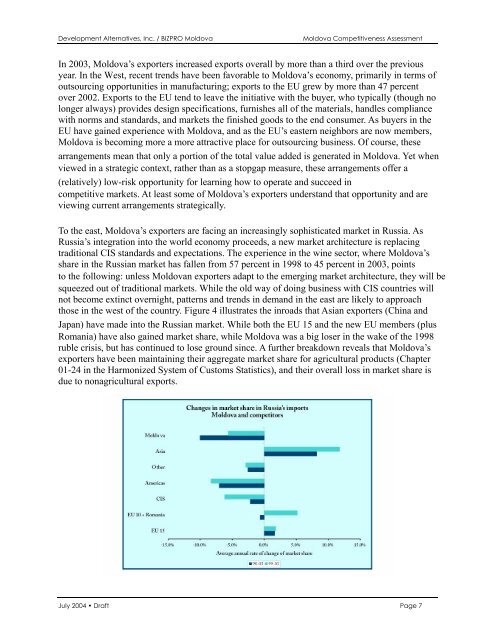Assessing Competitiveness In Moldova's Economy - Economic Growth
Assessing Competitiveness In Moldova's Economy - Economic Growth
Assessing Competitiveness In Moldova's Economy - Economic Growth
Create successful ePaper yourself
Turn your PDF publications into a flip-book with our unique Google optimized e-Paper software.
Development Alternatives, <strong>In</strong>c. / BIZPRO Moldova Moldova <strong>Competitiveness</strong> Assessment<br />
<strong>In</strong> 2003, Moldova’s exporters increased exports overall by more than a third over the previous<br />
year. <strong>In</strong> the West, recent trends have been favorable to Moldova’s economy, primarily in terms of<br />
outsourcing opportunities in manufacturing; exports to the EU grew by more than 47 percent<br />
over 2002. Exports to the EU tend to leave the initiative with the buyer, who typically (though no<br />
longer always) provides design specifications, furnishes all of the materials, handles compliance<br />
with norms and standards, and markets the finished goods to the end consumer. As buyers in the<br />
EU have gained experience with Moldova, and as the EU’s eastern neighbors are now members,<br />
Moldova is becoming more a more attractive place for outsourcing business. Of course, these<br />
arrangements mean that only a portion of the total value added is generated in Moldova. Yet when<br />
viewed in a strategic context, rather than as a stopgap measure, these arrangements offer a<br />
(relatively) low-risk opportunity for learning how to operate and succeed in<br />
competitive markets. At least some of Moldova’s exporters understand that opportunity and are<br />
viewing current arrangements strategically.<br />
To the east, Moldova’s exporters are facing an increasingly sophisticated market in Russia. As<br />
Russia’s integration into the world economy proceeds, a new market architecture is replacing<br />
traditional CIS standards and expectations. The experience in the wine sector, where Moldova’s<br />
share in the Russian market has fallen from 57 percent in 1998 to 45 percent in 2003, points<br />
to the following: unless Moldovan exporters adapt to the emerging market architecture, they will be<br />
squeezed out of traditional markets. While the old way of doing business with CIS countries will<br />
not become extinct overnight, patterns and trends in demand in the east are likely to approach<br />
those in the west of the country. Figure 4 illustrates the inroads that Asian exporters (China and<br />
Japan) have made into the Russian market. While both the EU 15 and the new EU members (plus<br />
Romania) have also gained market share, while Moldova was a big loser in the wake of the 1998<br />
ruble crisis, but has continued to lose ground since. A further breakdown reveals that Moldova’s<br />
exporters have been maintaining their aggregate market share for agricultural products (Chapter<br />
01-24 in the Harmonized System of Customs Statistics), and their overall loss in market share is<br />
due to nonagricultural exports.<br />
Figure 4: Shifts in the penetration of Russia’s import markets<br />
July 2004 • Draft Page 7
















